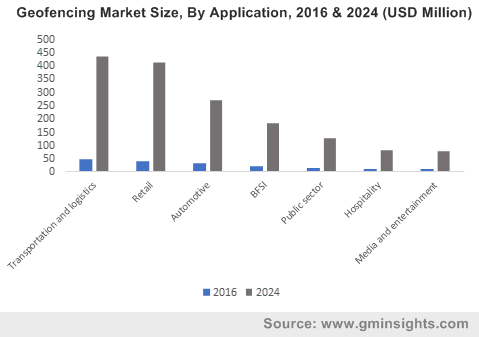Geofencing market to register a remarkable CAGR of 28% over 2017-2024, retail sector to drive the application matrix
Publisher : Fractovia | Published Date : 2018-02-06Request Sample
Touted as one of the most opportunistic business verticals of the sustainable and smart technologies industry, the growth chart of geofencing market is anticipated to scale new heights over the ensuing seven years. The massive proliferation of mobile devices coupled with the burgeoning requirement for proximity-based advertising, merchandising, and marketing solutions have contributed vigorously toward impelling the geofencing industry share augmentation. Apparently, geofencing technology has been making strong headways across myriad end-use domains including automotive, retail, BFSI, Media & Entertainment, transportation and logistics, hospitality, and public sector. In fact, the global geofencing is estimated to have recorded a total remuneration portfolio of close to USD 200 million in the year 2016, as per reliable estimates.
Geofencing Market Size, By Application, 2016 & 2024 (USD Million)

Given the backdrop of a tech-driven era, numerous businesses have been making extensive efforts to manage mobile resources efficiently to enhance the productivity of the workforce, by deploying location-based monitoring services. In consequence, the significance of geofencing solutions has grown immensely in the recent years, which has, in turn, opened up endless growth opportunities for the prominent market participants.
A brief overview of how retail sector would act as the principal growth avenue for geofencing industry
Speaking of the application spectrum of the overall market, it is quite imperative to state that the retail sector is projected to demonstrate the fastest growth during the estimated timeframe. Over the past few years, the overwhelming rise of e-commerce business platforms worldwide has presented unprecedented challenges to most of the brick-and-mortar retailers. Apparently, the retail market has now set its sights on innovative and smart technologies to tackle and compete against the ever-evolving marketing strategies of e-commerce giants. Moreover, it is undeniable that the geofencing technology has assisted traditional retailers to devise effective promotional campaigns and track business models of their competitors to retain and expand their existing customer base. Following are a few instances which underline the growing significance of geofencing industry across the retail space:
- The US-based home improvement retail behemoth, Home Depot had rolled out an app a few years ago which switches to an ‘in-store’ mode when a customer enters the store. By utilizing location-based technology, the app provides the customers with a map with specific product offerings based on their exact location and allows them to use additional services like the ‘product locator’ tool. Needless to mention, the deployment of such innovative technology would enhance the in-store customer experience which would further boost the growth prospects of the global geofencing market.
- Citing another instance, one of the leading clothing and accessories retailers American Eagle has recently unveiled rewards scheme to its customers by incentivizing try-ons. The US-headquartered firm utilizes geofencing technology to turn the in-store experience into an engrossing game, urging buyers to add additional items to their shopping cart to see what they may receive in return. Given that this strategy compels customers to seriously consider items they might have otherwise left on the rail, the likelihood of more purchases accentuates considerably. Apparently, this goes on to demonstrate the intent of market stakeholders to provide comprehensive results based on individualized shopping pattern.
- The conventional way of finding books in retail stores is being gradually transformed by the global geofencing industry. Citing an instance to highlight the altering dynamics of buying a book, Foyles uses geofencing technique to enhance the overall in-store consumer experience. The London based flagship of a seven-strong bookstore chain records the details of consumers after they connect to the in-store Wi-fi. Subsequently, the sophisticated version of the technique retargets the customers at a later date and uses the data to send emails regarding book offers.
With the rising application of geofencing technology for strengthening proximity marketing campaigns by retailers, market share from retail applications is forecast to grow at the fastest pace between 2017-2024, cite industry analysts.
Furthermore, it won’t be incorrect to claim that the intensifying battle between offline and online shopping stores would propel the growth potential of the global geofencing market over the forthcoming years. Add to it, increasing efforts to modernize the performance and capability of existing GPS network would further boost the adoption of geofencing solutions across the diverse set of business domains. Apparently, the commercialization potential of this business space is quite evident from estimates noted in the research report by Global Market Insights, Inc., which claims geofencing industry to accumulate remuneration of over USD 1.7 billion by 2024.